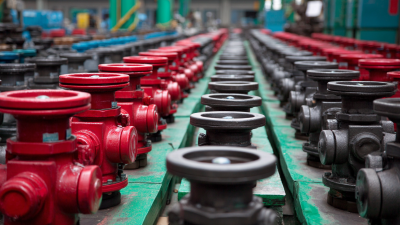
In industrial applications, the efficiency and precision of fluid management are critical for ensuring optimal operational performance. One essential tool in this regard is the flow glass indicator, which offers a reliable solution for monitoring fluid flow rates in a wide range of processes. According to a recent report by MarketsandMarkets, the global flow measurement market is projected to reach USD 8.8 billion by 2025, highlighting the growing importance of accurate flow measurement tools.

Flow glass indicators not only enhance visibility of fluid dynamics but also facilitate real-time monitoring and control, thereby reducing the risk of operational failures and improving safety standards. As industries continue to evolve, understanding the functionality and applications of flow glass indicators becomes paramount for engineers and technicians seeking to optimize their systems and ensure seamless processes.
Conventional flow glass indicators have played a vital role in industrial applications, serving as crucial tools for monitoring the flow of liquids and gases in various systems. These indicators utilize transparent glass tubes that allow operators to visually track fluid movement, making it easier to detect any anomalies in the flow rate or direction. The simplicity of their design ensures that they can be easily integrated into existing pipelines, providing immediate feedback without the need for complex electronic systems.

In many industries, such as water treatment, chemical processing, and food production, flow glass indicators enhance operational safety and efficiency. By providing real-time visual data, these indicators enable quick assessments and timely interventions if a blockage or leak occurs. Moreover, the glass construction allows for the observation of fluid's color and clarity, further assisting in quality control measures. As industries continue to seek reliable and cost-effective solutions, the enduring functionality of conventional flow glass indicators remains a preferred choice for many operators.
In the realm of industrial applications, flow glass indicators have long served as crucial tools for monitoring fluid movement. However, innovative alternatives are emerging to address some of the limitations associated with traditional flow glass indicators. One such alternative is the use of digital flow meters, which provide real-time data that enhances accuracy and allows for remote monitoring. These devices not only eliminate the fragility associated with glass but also integrate advanced technology, enabling users to collect data effortlessly and improve operational efficiency.
Moreover, transparent polymers are being utilized as a modern substitute for glass in flow indicators. These materials offer increased durability and resistance to extreme temperatures and pressures, making them ideal for harsh industrial environments. Additionally, they can be manufactured in various shapes and sizes, offering greater flexibility in design. As industries continue to evolve, the shift towards these innovative alternatives highlights a broader trend of advancing towards safer, more reliable, and efficient solutions in fluid monitoring and management.

When evaluating the cost-effectiveness of alternative flow indicators in industrial applications, it's essential to consider both initial expenses and long-term operational costs. Many companies opt for traditional flow indicators; however, innovative alternatives are emerging that can significantly reduce maintenance and replacement costs. For instance, some modern flow indicators are designed with advanced materials that withstand extreme conditions, thus prolonging their lifespan and minimizing operational downtime.
Additionally, the efficiency of alternative flow indicators in accurately measuring flow rates can lead to improved process optimization. Using smart technologies equipped with real-time monitoring capabilities can provide manufacturers with critical data that enhances decision-making and operational efficiency. Although the upfront investment in such technologies may seem higher, the potential for long-term savings and productivity boosts often outweighs these initial costs, making them a wise choice for industries focused on sustainability and efficiency.
| Flow Indicator Type | Cost ($) | Installation Complexity (1-5) | Maintenance Frequency (per year) | Durability (Years) |
|---|---|---|---|---|
| Glass Flow Indicator | 150 | 3 | 2 | 5 |
| Electronic Flow Meter | 300 | 4 | 1 | 10 |
| Rotary Vane Flow Indicator | 200 | 2 | 3 | 7 |
| Magnetic Flow Meter | 500 | 5 | 1 | 15 |
| Ultrasonic Flow Meter | 400 | 4 | 2 | 12 |
In industrial applications, the integration of flow glass indicators has become vital for enhancing process efficiency. However, the emergence of alternative technologies, including generative AI and other advanced digital solutions, is reshaping operational paradigms. According to recent studies, the economic potential of generative AI alone could add trillions of dollars to the global economy by significantly enhancing productivity. This transformation underscores the need for industries to adapt and leverage technological advancements to optimize their processes.
To maximize the benefits of flow glass indicators alongside these innovative technologies, businesses should consider implementing real-time monitoring systems. This integration allows for the immediate analysis of flow data, leading to timely decisions that can reduce downtime and improve overall efficiency. Moreover, with advancements in green technology, companies can further enhance their sustainability efforts, aligning with the global push towards environmentally friendly practices.
Tips for companies looking to adopt these technologies include conducting thorough assessments of current systems to identify areas for improvement and training staff on new technologies to ensure proper implementation. Embracing personalized adaptive learning in workforce training can also boost engagement and performance, fostering a more competent and efficient team ready to tackle the challenges of modern industrial processes.
In the realm of industrial applications, flow glass indicators play a critical role in monitoring the movement of liquids and gases. However, their implementation requires careful consideration of safety protocols to prevent accidents and ensure operational efficiency. As industries face growing challenges such as high turnover rates, particularly in sectors like healthcare where safety is paramount, it is essential to adopt robust indicator solutions that prioritize both functionality and security.
When introducing new indicator systems, industries must adhere to rigorous safety standards. Research indicates that workplace safety measures can effectively reduce employee turnover and enhance overall morale. For example, implementing comprehensive safety training programs for staff has been shown to boost confidence and job satisfaction, leading to a more stable workforce.
**Tips for Enhancing Safety with Flow Indicators:**
- Regularly conduct safety audits to identify potential hazards associated with the flow systems.
- Involve employees in safety protocol discussions to foster a culture of safety and accountability.
- Ensure that all indicators are compliant with established safety guidelines and undergo routine maintenance to prevent malfunctions.
By focusing on these considerations, industries can not only improve their operational safety but also create a more enjoyable and secure workplace for all employees.
This chart illustrates the effectiveness of flow glass indicators across multiple industrial applications based on user feedback and performance metrics. The data reflects the average effectiveness rating (out of 10) for each application.





